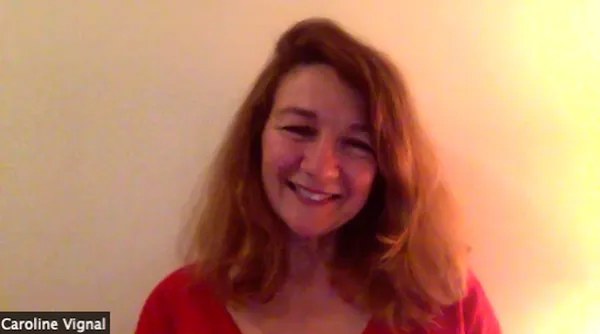 |
| Caroline Vignal on Howard Hawks’s Rio Bravo: “I think the main thing is that I’m really a fan of Dean Martin, mostly as a singer.” |
Laure Calamy’s wildly amusing performance in Caroline Vignal’s My Donkey, My Lover, And I (Antoinette Dans Les Cévennes) earned her the César Award for Best Actress, besting the Lumière Award co-winners Barbara Sukowa and Martine Chevallier, the stars of Filippo Meneghetti’s (Oscar-shortlisted and César Best First Feature Film winner) Two Of Us (Deux), Virginie Efira in Albert Dupontel’s multiple César Award-winning Bye Bye Morons, and Camélia Jordana for Emmanuel Mouret’s Love Affair(s), which received a record 13 nominations, winning just one for Best Supporting Actress Emilie Dequenne.
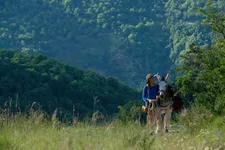 |
| Antoinette (Laure Calamy) with Patrick: “The Cévennes have room to roam. In France we’re so steeped in the Western …” |
Shot by Simon Beaufils with a score by Matei Bratescot, My Donkey, My Lover, and I takes us on a Robert Louis Stevenson tour in the Cévennes with Antoinette (Calamy) and her co-star, a donkey named Patrick.
Antoinette, a schoolteacher, is having an affair with Vladimir (Benjamin Lavernhe), the father of Alice (Louise Vidal), who is one of her pupils. When he tells her that he and his wife (Eléonore, played by Olivia Côte) and their daughter are going to walk the Stevenson trail with a donkey, Antoinette decides that it might be a good idea to surprise her lover and do the same. If all this sounds like a manual of very bad decision-making, well, it is. And that is truly only the beginning.
In ridiculous clothing, totally unfit for hours of hiking, our heroine embarks on this life-altering journey and encounters an astounding array of fellow wanderers. There is a couple that dresses in matching shirts to disguise their mismatched points of view, a man proud to be without luggage, a red-capped stalker from the corporate world, motorcycle cowboys, professional hostel hosts and many more. On the first evening already, Antoinette spills the entire sad tale about her lover and her mission to total strangers who interrogate her at first casually, then more and more insistently.
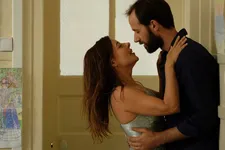 |
| Antoinette (Laure Calamy) with Vladimir (Benjamin Lavernhe) |
But it is Patrick, a donkey of great character and stubbornness, who has the greatest impact. In Howard Hawks’s Rio Bravo, Dean Martin sang about his “three good companions - my rifle, my pony, and me.” It always struck me as curious that he included himself in the list. For Antoinette, her own companionship turns out to be vital. A sequence reminiscent of Snow White awaking in the forest, an encounter with a healer (Ludivine Bluche) who has a very special connection to Patrick, and a dream-like, half enchanted ending round out this highly original picture. Calamy and the donkeys give it their all and the more the ridiculous is allowed to happen, the more we are edging towards the sublime.
From Paris on St.Patrick’s Day, Caroline Vignal joined me on Zoom for an in-depth conversation on My Donkey, My Lover, and I (Antoinette dans les Cévennes).
Anne-Katrin Titze: First of all congratulations for Laure Calamy winning the César for this role! She is the centre of it all, together with the donkey. Are you aware that it is St.Patrick’s Day today?
Caroline Vignal: Oh no, I didn’t know that.
AKT: I thought it was great to celebrate Patrick, the donkey, on St. Patrick’s Day!
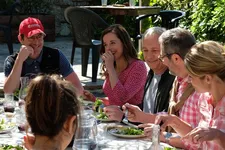 |
| Antoinette (Laure Calamy) with fellow hikers of the Robert Louis Stevenson trail in the Cévennes |
CV: So, you know I called the donkey Patrick because a long time ago I went on a hike with a donkey and that donkey was called Patrick. He had been named Patrick because he was of Irish background and his owner named him Patrick in honour of St. Patrick’s Day. I didn’t know this was today but it’s very funny.
AKT: I thought it absolutely perfect timing. I really love your English title. Are you a big fan of Rio Bravo?
CV: Actually Rio Bravo is a film that I like but I can’t say that I know it very well. I think the main thing is that I’m really a fan of Dean Martin, mostly as a singer.
AKT: So am I. I like very much when the song comes in at the end, because suddenly we in the audience realise that maybe we are watching a Western.
CV: Yes, absolutely. I thought that I was making a kind of a Western, because the Cévennes is a rare area in France where you actually have room. It’s rare in France to find a place that’s basically uncultivated and not very populated. The Cévennes have room to roam. In France we’re so steeped in the Western that you really can’t see this kind of area without thinking of the Western. Of course in my movie the character has a donkey and not a horse.
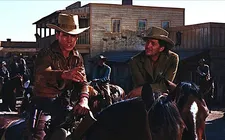 |
| Ricky Nelson and Dean Martin in Rio Bravo |
For instance with the music, with the composer [Matei Bratescot] we were thinking about paying tribute, winking towards the Western. Similarly with Antoinette’s hat. There are a lot of aspects making light reference. That also was behind the choice of using the scope format, cinemascope. The director of photography [Simon Beaufils] and I thought, this is a comedy about a young woman who is running after her boyfriend, but maybe if we use cinemascope it will give it the width of a small epic. So that was also a relation to the Western that we thought about.
AKT: I was amazed at the beginning of your film. The children counting backwards and we have no idea. I think you have nobody in the audience guessing what is going to come. The fact that she is changing her clothes says so much about her and is so totally absurd. How on earth did you come up with this for the start of your film?
CV: I don’t know, it doesn’t seem so absurd to me. It even feels kind of logical that she would change [into a slinky silver gown in the middle of the school day] in the classroom. It amused me. Most people think of a teacher as this super responsible person, this person in charge of twenty or thirty children. But we see her behaving like this and the kids just look at her with fascination. They are blown away by her. And it does give you the character from the outset.
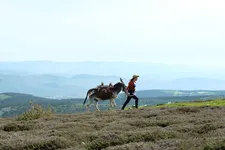 |
| Caroline Vignal: “Of course in my movie the character has a donkey and not a horse.” |
AKT: Several times during your film I thought how she is behaving, what she is doing is so embarrassing that it borders on the sublime. I’ve never seen that reach from the embarrassing to the sublime like this before.
CV: It’s funny because when Laure Calamy won her César Award she said that she and I share a love for funny pathetic-ness or pathetic funniness. And it’s true that there is nothing that makes me laugh more in life than the pathetic. It’s kind of the ultimate in self-derision. And it’s true that there is a danger with the character of Antoinette that people could not like her because she is too extreme.
I thought the fact that she is always on the edge, that she is always doing something embarrassing actually makes the audience like her more. They’re like “Oh no, she’s not going to do that! Poor girl!” I really love going all the way with things. You know, recently I rewatched Blake Edwards’s film 10. And that’s a very similar kind of character. It’s a male character in this case who is even more ridiculous. It’s true that it’s a kind of character you see more rarely with a woman.
AKT: Very true. Very important point. We are not used to seeing women embrace this kind of ridiculousness. Women are in a different position. I am thinking for example when the guy with the red hat, the red cap, is following her. He is beating the donkey. There is an addition to the ridiculous, a sense of danger. He is really super creepy. I think it’s more dangerous for women to embrace the ridiculous.
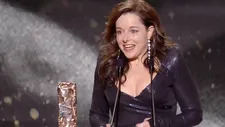 |
| Caroline Vignal: “It’s funny because when Laure Calamy won her César Award she said that she and I share a love for funny pathetic-ness or pathetic funniness.” |
CV: Yes, maybe this is what we can aim for now. Maybe the next stage of feminism is to be ridiculous, to have the right to be ridiculous. I was thinking maybe not so much Blake Edwards, but the entire career of Woody Allen, all his characters are based on this kind of making fun of himself. Maybe women in cinema should now have that right as well. That’s going to be my mission.
AKT: Good mission. I loved how you went all out with Disney’s Snow White. That scene with the bunnies and the little fox and the deer - you really wanted to stage your version of Disney, I suppose? Talk a bit about your work with these animals and also with the donkey Patrick.
CV: My DP and I had rewatched the scene in question from Snow White and we tried to reproduce the shots exactly but we couldn’t do it perfectly because for instance the Disney film has thirty birds going tweet, tweet, tweet, and we couldn’t get thirty birds. Still it was long to do this and perhaps I shouldn’t say this, but we couldn’t do it in one shot. You couldn’t get all the animals and the donkey and Antoinette in one single shot.
So first we did a shot of Antoinette and Patrick sleeping. And even that wasn’t simple, because actually donkeys don’t lie down. So in this case Patrick’s trainer had taught him to lay down so that Laure Calamy could lie with him. And then we shot the animals one after another and added them digitally.
AKT: It works, it really works. You said you had an Irish donkey, so you did the Robert Louis Stevenson tour before? Was that the starting point of the film? Or did you first have the idea of the film and then took the tour? Which order was it?
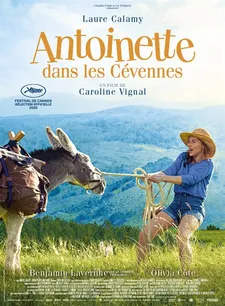 |
| Antoinette Dans Les Cévennes poster |
CV: Actually it was both at once. Initially I did a lot of hikes with donkeys because I have a daughter and when she was a little girl, it was a way to get her to walk. It was like bait for her to have the donkey [just to have a donkey in the English title was enough bait for me to see her movie]. We didn’t do the Stevenson hike because it’s 222 kilometres long.
One time when we were doing these hikes we had a donkey called Patrick and we had a lot of funny adventures with him and I thought, hmm, maybe there’s a film somewhere here. But I didn’t have the idea for the character yet, I just knew I wanted to make a film in that region, in those landscapes and a character with a donkey walking. Also the kinds of things that happen when you meet these random people in the shelters along the way. It took time to find the actual idea for the character. Once that came along and I was writing the screenplay, I did do the Robert Louis Stevenson trail to see what it was all about. But I didn’t take a donkey. I didn’t have the courage to do so.
AKT: Thank you for this very entertaining, very unusual film. With everything going into lockdown, are you working on a new project?
CV: I’m trying, yes. I’m just moving from one apartment to another now. I’m making up my boxes.
AKT: In Paris?
CV: I’m the last person, I think, to buy an apartment in Paris when everybody wants to leave. But yes, I’m trying to write.
AKT: Looking forward, and again Happy St. Patrick’s Day!
CV: To you too!
Coming up - Caroline Vignal on working with donkeys, a healing, a confrontation, casting for My Donkey, My Lover, And I (Antoinette dans les Cévennes).





















